It looks like you're using an Ad Blocker.
Please white-list or disable AboveTopSecret.com in your ad-blocking tool.
Thank you.
Some features of ATS will be disabled while you continue to use an ad-blocker.
The tree and it's fruit was particularly sacred within the Cult of Hathor and is often seen in tombs in the context of providing nourishment for the dead, thus it had association with eternal life.
It is the Golden One, the Lady of Drunkenness, of Music, of Dance,
Of Frankincense, of the Crown, of Young Women,
Whom men acclaim because they love her!
It is the gold of the divine entities, who comes forth at Her season
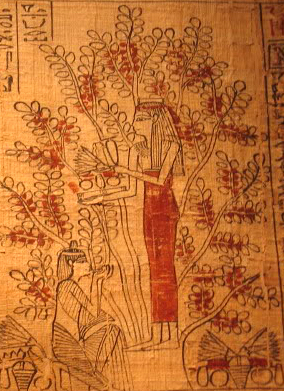
The Fig as the Tree of Life finds correspondence with cultures such as Sumeria, Elam and that of the Indus Valley, in Message from the Pleiades i suggested these traditions could probably be traced back at least as far as Gobekli Tepe, some 12,000 years ago, and that they are associated with a Cow Goddess, consort of the Bull of Heaven, and her all singing all dancing entourage, the Pleiades, that were seen as journeying to the Earth aboard the good ship 'Bull of Heaven'
The fig is a common sexual symbolism of female genitalia around the Mediteranean and the Egyptians also in relating the fruit to Hathor were making that association, as organic Life is generated by sexuality, but also there are broader implications of the importance of pleasure and happiness, that what Hathor pours out to nourish the deceased is not water but wine in which the fig was used for fermentation, nourishment not only for the physical Ka, but also the Ba, the soul.If the Tree of Life is to be understood as a cosmic axis, for the ancient Egyptians then the highest aspect of this was Hathor.
We propitiate Your Majesty every day.
Your heart rejoices at hearing our songs.
We rejoice when we see You, day by day.
Our hearts are jubilant when we see Your Majesty.
You are the Lady of Garlands, the Mistress of Dance,
The Lady of Unending Drunkenness.
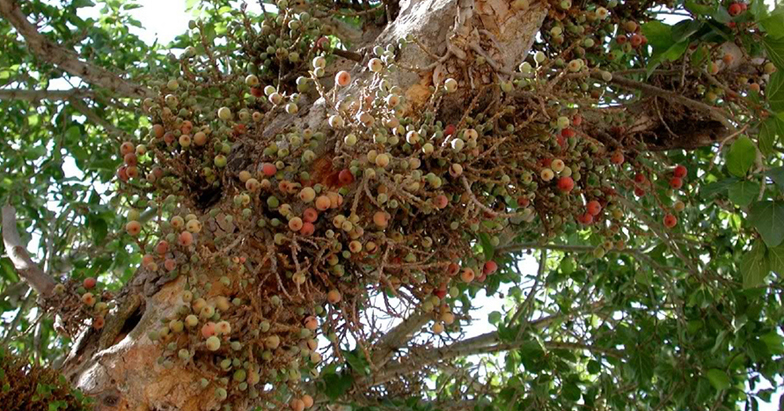
Hathor is understood to be the deity who welcomes the worthy dead, offers them refreshments of food and drink, and leads the way into the blessed beyond. One of the desires of the deceased was to be "in the following of Hathor." Hathor was one of the most important goddesses invoked at funerals: "The doors of Heaven open and the deity comes forth The Golden Goddess has come." In some tombs her image outnumbers those of Osiris and Anubis. "Seek the Cow Mother" is written on the walls of the tombs of early kings.
All hail, jubilation to You, O Golden One,
Sole ruler, serpent of the supreme lord himself!
Mysterious One who gives birth to the divine entities,
Forms the animals, models them as She pleases, fashions men
O Mother! Luminous One Who Thrusts Back the Darkness,
Who illuminates every human creature with Her rays
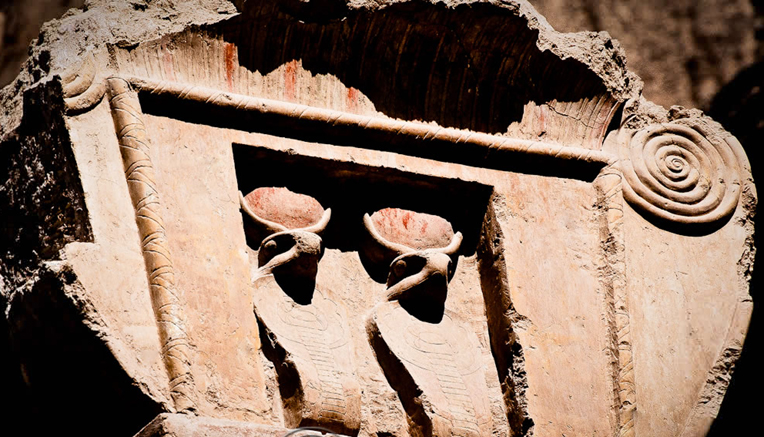
Hathor having many aspects in Egypt could also be understood as a serpent generally indicative of Feminine in a metaphysical sense, and thus could be associated as much with the roots of the tree as the upper branches and fruit, so in many ways it was her tree but the Pharoah can sometimes be seen associate with the trunk in iconography were Thoth and Seshat write his name of the leafs of the tree of life.
Egyptians considered the fig a delicacy. The fruit gained popularity in ancient Egypt as it grew all over the countryside. Its abundance made it a staple food in ancient Egypt along with foods such as garlic, olives and bread. Because of its natural sweetness, the Egyptians also used figs to enhance the flavors of other foods and drinks such as wines. Archaeologists from the University of Pennsylvania have suggested that the fig served as a starter for the yeast that ancient Egyptians would use to ferment grape juice and turn it into wine.
"The beauty of Your face
Glitters when You rise,
O come in peace.
One is drunk
At Your beautiful face,
O Gold, O Hathor
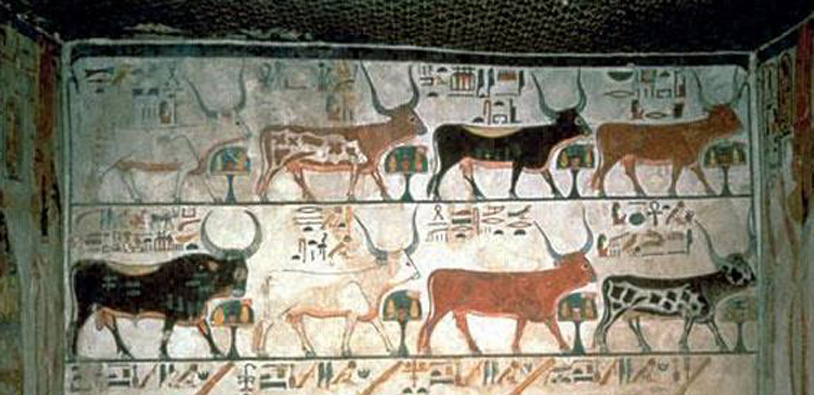
In the ancient Egypt seven goddesses, represented by seven cows, composed the celestial herd that provides the nourishment to her worshippers. This herd is observed in the sky as a group of stars, the Pleiades, close to Aldebaran, the main star in the Taurus constellation. For many ancient populations, Pleiades were relevant stars and their rising was marked as a special time of the year.
"Seven Hathors" who were associated with fate and fortune telling. It was thought that the "Seven Hathors" knew the length of every childs life from the day it was born and questioned the dead souls as they travelled to the land of the dead They seemed to be linked with not only fortune telling, but to being questioners of the soul on its way to the Land of the West. These goddesses were worshipped in seven cities in Egypt
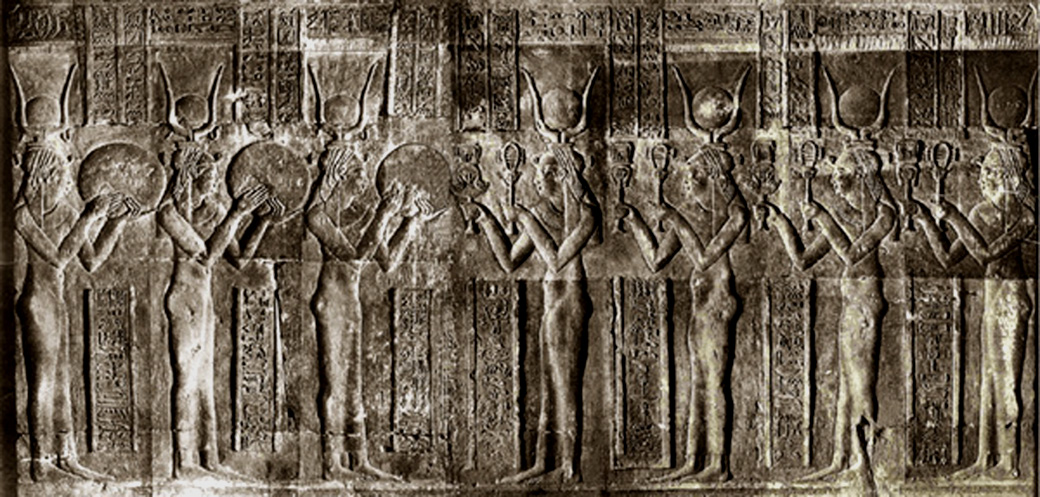
Come in peace, progress in joy,
Your heart is sweetened by hearing prayers,
Hathor the Great, Mistress of Iunet,
The Eye of Ra, Mistress of Heaven,
Sovereign of All the Gods,
The Great Serpent, the Mistress of the Great Sanctuary
So then this is the Egyptian take on what a Tree of Life should be all about, and i suppose as it was related to the Bull of Heaven in it's sense of great driving Cosmic force what they understood life in general should be about, i guess also that any self respeecting Aliens that came from the general direction of the Pleiades might be expected to uphold these traditions but who knows, what can probably be said with certainty is that the Cult of Hathor was the best argument for organized Religion.
Hathor’s hair is dressed in so characteristic a fashion that the style now bears her name: archaeologists have dubbed it the “Hathor hair-do.” This style is utterly distinctive and perhaps surprisingly modern to our eyes. It is not the heavily bejeweled, elaborately braided hair so commonly depicted in other ancient Egyptian imagery. Rather it is simplicity in the extreme: a simple flip, often parted down the middle. Invariably the queen of Egypt was portrayed in sculpture as wearing the long wig characteristic of the goddess, as if to emphasize her role as the physical manifestation of Hathor on earth
While other ancient Egyptian hairstyles are instantly recognizable even today as solely Egyptian, the Hathor hair-do seems to have set an international style, in particular traveling all over the Middle East. Other goddesses are depicted wearing this style, such as Ishtar, Anat, and Astarte; in fact, it seems to have become the goddess hairstyle, favored by all the most fashionable deities
Yes they had the general association of prosperity of the Land, but also with the determining of fate and Divination, and the dream is in the context of the Hebrew making claim to be better at this than the Egyptians, as they later did with the Babylonians in the Daniel narrative, establishing the Prophetic tradition that understood itself as being able to determine the fate of the World.
Pajamathief
There always seems to be a tree of great importance in different religions/mythologies such as Ygdrassil for the Norse. I wonder if it's literal, and if they're all referring to the some great tree that once existed. Or, if it's symbolic of stars/planets that were important to their everyday life.
Trees encode several different things from time immemorial!
First we can use them as a metaphor for families in both the structure of a family genealogy and the hierarchical nature of species within evolution or classifications.
They encode fractals through the golden ratio found throughout the universe in the use of the Fibonacci sequence which controls branching patterns making each branch capable of producing a leaf that will see sunlight in a balanced form.
They are extremely long lived and some of the oldest and tallest living things on the planet. Some so old they predate most known civilizations by a 1,000 years! They prevent soil from washing away and create mini-biospheres throughout their life and death and finally in decay.
For humans they provide food and shelter as well as building materials, weapons, shade and resources that have been essential in the development of human civilizations. There is no wonder they show up revered in almost every every civilization except maybe the current one. But they will be here longer than it as well and perhaps one day we will take them (or just one) back to the stars...
That movie looks interesting, never seen it so i've downloaded and will give it a watch so thanks
The Tree of Life seems to be of such an early date and sharing many particular and peculiar associations such as with the Pleiades around the world that it appears to be from a singular regional source and to have spread with only minor variations developing, literally an implanted teaching device.
smphillips.8m.com...
smphillips.8m.com...
which reveals the transcendental nature of this MATHEMATICAL structure, proves rigorously that its mathematical properties are analogous to the exceptional Lie group E8 at the heart of superstring theory and shows that it is isomorphic to other sacred geometries, being different representations of the ONE universal blueprint governing reality.
No, i think i'll stick with the all singing and dancing Hathor interpretation rather than the speculation of Jewish mystagogues of the Middle Ages thank you very much, after all the thread is about how the Egyptians saw things, obviously you couldn't care less but i do
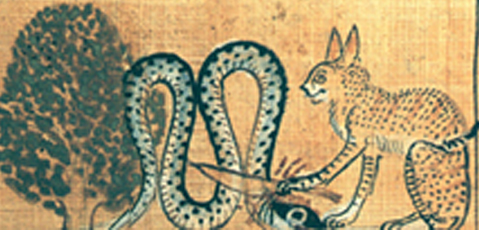
The Tree of Death a fig tree? Your dreaming!
Metatron into Malkuth is genius it basically states that for anything lower then Metatron. Metatron has to create it and it can only do that by falling flat on it's face.
Malkuth who is created by Metatron has to be one with Metatron therefore must rise from it's lowest position to the highest position. Otherwise it cannot be the nest that catches Metatron.
And we can get a great glimpse of the universe works through this philosophy. You have to experience your own dream.
Kantzveldt
the thread is about how the Egyptians saw things,
You might find this thread of mine interesting ...
ATS Thread - The Ancient Egyptian Principle of Ma'at
have you heard of Druidry?
Brief History of Druidry
Tree Lore
Order of Bards, Ovates & Druids
This history is about 25 thousand years old and all of the laws are based on the roots of the Sacred Trees.
In the Classical world it was regarded as the Tree of Life as its deep roots penetrate as deep into the Underworld as its branches soar to the sky, and it was held sacred to Zeus and Jupiter. In Scandinavia the oak was the tree of the Thunder-God, Thor, as it was to his Finnish counterpart, Jumala.
Indeed it's always important to consider the way of Ma'at in order to retain balance and true perspective, in many ways this is maintaining the first innocent principles of conscious Creation as arose with Heka.
reply to post by Thurisaz
Yes i've heard of Druidary, every Deity who was anybody having their own particular sacred tree does date back at least to Sumerian times were it is first recorded, in terms of the Mes trees. Of course trees are subject to regional limitations in terms of their habitat and thus a Ficus Sycomorus say isn't going to mean much to Northern European folk, so one finds differences of opinion as to what constitutes a Tree of Life across the globe.
Kantzveldt
reply to post by abeverage
That movie looks interesting, never seen it so i've downloaded and will give it a watch so thanks
The Tree of Life seems to be of such an early date and sharing many particular and peculiar associations such as with the Pleiades around the world that it appears to be from a singular regional source and to have spread with only minor variations developing, literally an implanted teaching device.
Of course...
Interestingly enough it does not have to do with the Pleiades but Orion but I think the sentiment is the same.
yes beliefs are endemic.
I find it interesting that many of the beliefs are so similar.
Yes i had sort of started watching it in the past but fallen asleep, as you say it's based upon the M42 Galaxy in Orion, i've looked at that here and here and elsewhere, so i do consider it important, a place of death and a place of first life.
The association of that place as a hearth of the first fire of Creation and from were it is dispersed is interesting, in a sense perhaps that is the location for the seed from which our tree develops, the Pleiades seem to have more association with the highest branches and fruit of such a tree and the sharing of such gifts, we see below this axis toward Taurus.
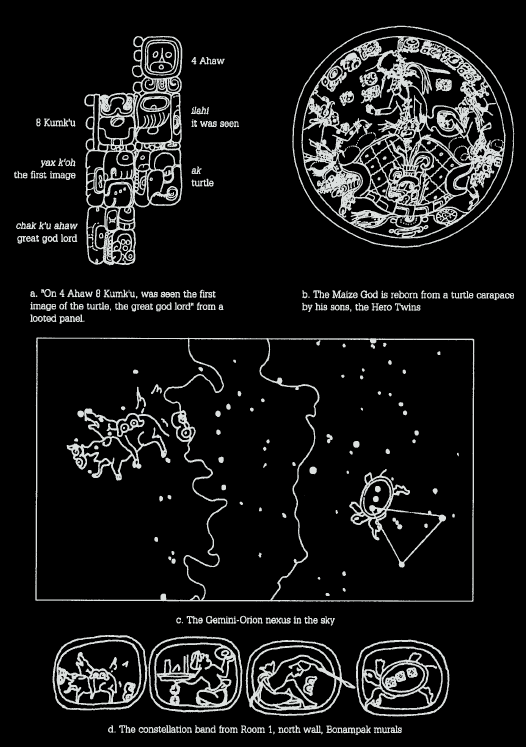
The movie never looks beyond the M42 constellation and the symbolism of seeding, never considers the fruits of such a tree, and thus Queen Isabella is failed, that will never do
M42 the Orion Nebula is still an active cluster, basically a stellar nursery where as M45 the Pleiades is diffuse and in it's middle ages no longer giving birth to new stars thus having more opportunities for life to have arisen much like our solar system.
In the movie The Fountain, Tommy in the year 2500 takes Izzy who's DNA is infused in a great tree, to where a star dies (stellar death = rebirth) within Orion to meet again.
We are all made of star dust and it is through this phoenix transformation that will occur in a younger star formation that will create a new star system much like our own.
In what you are describing it would make sense that our world was seeded by the older middle age Pleiadian cluster...
In one of James Churchward's books on Mu, (I have forgotten which one) he showed the symbol of a tree with many branches surrounded by fish. He was told by his Hindu teacher that the symbol commemorated the inundation of Mu, the motherland of man.
That being said, it seems to me that there is definitely a downside to Hathor, and that would be in her role as Sekhmet.
In a myth about the end of Ra's rule on the earth, Ra sends Hathor or Sekhmet to destroy mortals who conspired against him. In the myth, Sekhmet's blood-lust was not quelled at the end of battle and led to her destroying almost all of humanity, so Ra poured out beer dyed with red ochre or hematite so that it resembled blood. Mistaking the beer for blood, she became so drunk that she gave up the slaughter and returned peacefully to Ra.
Based on that famous ancient Egyptian tale, it would seem to be more realistic to say that Hathor represented the Tree of Life as well as Death.
Yes as seen here this is Hathor of the West, the Evening star aspect of Venus, Eye of Re, the Shepherds delight, a cow eyed Goddess, Sekhmet is the Lioness aspect of the East.
The most interesting aspect of 'The Book of the Celestial Cow' is the retirement of Ra.
o stop his Eye and daughter from completely destroying mankind, Re tricks her into drinking large quantities of red beer. Sekhmet is so drunk that she stops recognizing mankind. He then announces to the deities his decision to no longer remain with gods and men, but to withdraw to the sky where he can live for himself. The sky-goddess Nut transforms herself into a cow, and placing himself on its back, Re proceeded to his palace. The land lay in utter darkness.
Although the surviving humans set out with bows and clubs to punish the remaining evildoers, Re, who's power is in no way diminished by his retreat, rejects them as well as their actions. Utterly disappointed with mankind, he ascends to his palace on the back of the Heavenly Cow.
Among the spells associate with this Celestial Cow and written on it;
"I am who I am. I will not let them take action."
The Destruction of Mankind - the New World Order &
the Magic of Re
-
Sick sick sick
Other Current Events: 3 hours ago -
Comcast dumping MSNBC
Mainstream News: 6 hours ago -
President-elect TRUMP Picks MATT GAETZ for his ATTORNEY GENERAL - High Level PANIC Ensues.
2024 Elections: 9 hours ago
-
Breaking: FBI Agents Raid Polymarket CEO After Betting Site Predicts Trump Win
General Conspiracies: 15 hours ago, 18 flags -
The Guardian quits Elon Musk's X social media platform
Mainstream News: 16 hours ago, 17 flags -
HHS Spent Hundreds of Millions of Dollars on DEI Initiatives Under Biden, Watchdog Finds
US Political Madness: 15 hours ago, 11 flags -
President-elect TRUMP Picks MATT GAETZ for his ATTORNEY GENERAL - High Level PANIC Ensues.
2024 Elections: 9 hours ago, 10 flags -
Comcast dumping MSNBC
Mainstream News: 6 hours ago, 9 flags -
Mike Tyson returns 11-15-24
World Sports: 14 hours ago, 4 flags -
Sick sick sick
Other Current Events: 3 hours ago, 1 flags
-
-@TH3WH17ERABB17- -Q- ---TIME TO SHOW THE WORLD--- -Part- --44--
Dissecting Disinformation • 3259 • : MetalThunder -
Sick sick sick
Other Current Events • 14 • : SprocketUK -
WATCH LIVE: US Congress hearing on UFOs, unidentified anomalous phenomena
Aliens and UFOs • 36 • : xWorldxGonexMadx -
Russia Ukraine Update Thread - part 3
World War Three • 6808 • : andy06shake -
How can you defend yourself when the police will not tell you what you did?
Posse Comitatus • 70 • : Freeborn -
Election statistics question
2024 Elections • 24 • : PorkChop96 -
Breaking: FBI Agents Raid Polymarket CEO After Betting Site Predicts Trump Win
General Conspiracies • 20 • : Dandandat3 -
Mood Music Part VI
Music • 3702 • : BrucellaOrchitis -
Elon's Starlink Stole The Election For Trump--Leftist Conspiracy Theorists Charge
General Conspiracies • 36 • : network dude -
Waterloo in 20mm world's largest diorama (on view at NAM Chelsea Oct 20 & 21) new pics added 10 -16
Member Art • 49 • : BrucellaOrchitis
